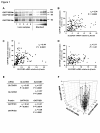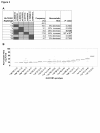Genetics is a major determinant of expression of the human hepatic uptake transporter OATP1B1, but not of OATP1B3 and OATP2B1
- PMID: 23311897
- PMCID: PMC3706890
- DOI: 10.1186/gm405
Genetics is a major determinant of expression of the human hepatic uptake transporter OATP1B1, but not of OATP1B3 and OATP2B1
Abstract
Background: Organic anion transporting polypeptide (OATP) 1B1, OATP1B3, and OATP2B1 (encoded by SLCO1B1, SLCO1B3, SLCO2B1) mediate the hepatic uptake of endogenous compounds like bile acids and of drugs, for example, the lipid-lowering atorvastatin, thereby influencing hepatobiliary elimination. Here we systematically elucidated the contribution of SLCO variants on expression of the three hepatic OATPs under consideration of additional important covariates.
Methods: Expression was quantified by RT-PCR and immunoblotting in 143 Caucasian liver samples. A total of 109 rare and common variants in the SLCO1B3-SLCO1B1 genomic region and the SLCO2B1 gene were genotyped by MALDI-TOF mass spectrometry and genome-wide SNP microarray technology. SLCO1B1 haplotypes affecting hepatic OATP1B1 expression were associated with pharmacokinetic data of the OATP1B1 substrate atorvastatin (n = 82).
Results: Expression of OATP1B1, OATP1B3, and OATP2B1 at the mRNA and protein levels showed marked interindividual variability. All three OATPs were expressed in a coordinated fashion. By a multivariate regression analysis adjusted for non-genetic and transcription covariates, increased OATP1B1 expression was associated with the coding SLCO1B1 variant c.388A > G (rs2306283) even after correction for multiple testing (P = 0.00034). This held true for haplotypes harboring c.388A > G but not the functional variant c.521T > C (rs4149056) associated with statin-related myopathy. c.388A > G also significantly affected atorvastatin pharmacokinetics. SLCO variants and non-genetic and regulatory covariates together accounted for 59% of variability of OATP1B1 expression.
Conclusions: Our results show that expression of OATP1B1, but not of OATP1B3 and OATP2B1, is significantly affected by genetic variants. The SLCO1B1 variant c.388A > G is the major determinant with additional consequences on atorvastatin plasma levels.
Figures



Similar articles
-
Organic anion transporting polypeptide 1B1: a genetically polymorphic transporter of major importance for hepatic drug uptake.Pharmacol Rev. 2011 Mar;63(1):157-81. doi: 10.1124/pr.110.002857. Epub 2011 Jan 18. Pharmacol Rev. 2011. PMID: 21245207 Review.
-
Functional characterization for polymorphic organic anion transporting polypeptides (OATP/SLCO1B1, 1B3, 2B1) of monkeys recombinantly expressed with various OATP probes.Biopharm Drug Dispos. 2019 Feb;40(2):62-69. doi: 10.1002/bdd.2171. Epub 2019 Feb 10. Biopharm Drug Dispos. 2019. PMID: 30652318
-
Visualization of hepatic uptake transporter function in healthy subjects by using gadoxetic acid-enhanced MR imaging.Radiology. 2012 Sep;264(3):741-50. doi: 10.1148/radiol.12112061. Epub 2012 Jul 6. Radiology. 2012. PMID: 22771883
-
Interindividual and interethnic variability in drug disposition: polymorphisms in organic anion transporting polypeptide 1B1 (OATP1B1; SLCO1B1).Br J Clin Pharmacol. 2017 Jun;83(6):1176-1184. doi: 10.1111/bcp.13207. Epub 2017 Jan 19. Br J Clin Pharmacol. 2017. PMID: 27936281 Free PMC article. Review.
-
No impact of SLCO1B1 521T>C, 388A>G and 411G>A polymorphisms on response to statin therapy in the Greek population.Mol Biol Rep. 2014 Jul;41(7):4631-8. doi: 10.1007/s11033-014-3334-z. Epub 2014 Mar 26. Mol Biol Rep. 2014. PMID: 24668570
Cited by
-
The SNPs rs429358 and rs7412 of APOE gene are association with cerebral infarction but not SNPs rs2306283 and rs4149056 of SLCO1B1 gene in southern Chinese Hakka population.Lipids Health Dis. 2020 Sep 5;19(1):202. doi: 10.1186/s12944-020-01379-4. Lipids Health Dis. 2020. PMID: 32891149 Free PMC article.
-
The Role of Next-Generation Sequencing in Pharmacogenetics and Pharmacogenomics.Cold Spring Harb Perspect Med. 2019 Feb 1;9(2):a033027. doi: 10.1101/cshperspect.a033027. Cold Spring Harb Perspect Med. 2019. PMID: 29844222 Free PMC article. Review.
-
Effect modification by region in the associations of LEP G2548A and LEPR Q223R polymorphisms with statin-induced CK elevation.Oncotarget. 2017 Nov 18;8(64):107565-107576. doi: 10.18632/oncotarget.22506. eCollection 2017 Dec 8. Oncotarget. 2017. PMID: 29296187 Free PMC article.
-
Histogram analysis of gadoxetic acid-enhanced MRI for quantitative hepatic fibrosis measurement.PLoS One. 2014 Dec 2;9(12):e114224. doi: 10.1371/journal.pone.0114224. eCollection 2014. PLoS One. 2014. PMID: 25460180 Free PMC article.
-
Toward Prospective Prediction of Pharmacokinetics in OATP1B1 Genetic Variant Populations.CPT Pharmacometrics Syst Pharmacol. 2014 Dec 10;3(12):e151. doi: 10.1038/psp.2014.50. CPT Pharmacometrics Syst Pharmacol. 2014. PMID: 25494035 Free PMC article.
References
-
- Giacomini KM, Huang SM, Tweedie DJ, Benet LZ, Brouwer KL, Chu X, Dahlin A, Evers R, Fischer V, Hillgren KM, Hoffmaster KA, Ishikawa T, Keppler D, Kim RB, Lee CA, Niemi M, Polli JW, Sugiyama Y, Swaan PW, Ware JA, Wright SH, Yee SW, Zamek-Gliszczynski MJ, Zhang L. Membrane transporters in drug development. Nat Rev Drug Discov. 2010;9:215–236. doi: 10.1038/nrd3028. - DOI - PMC - PubMed
LinkOut - more resources
Full Text Sources
Other Literature Sources

